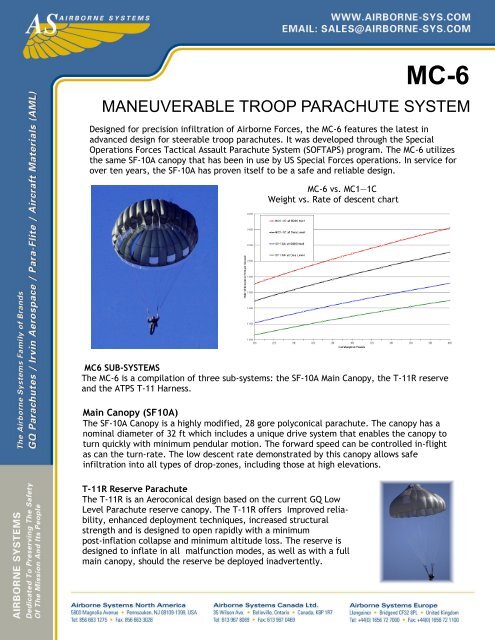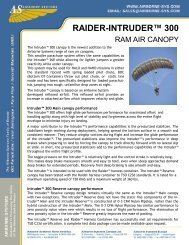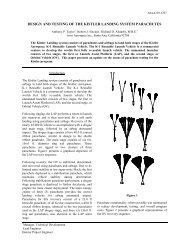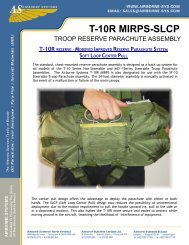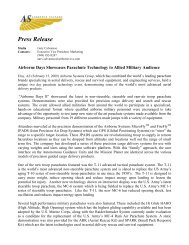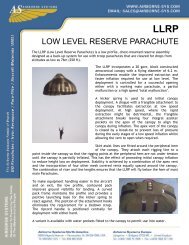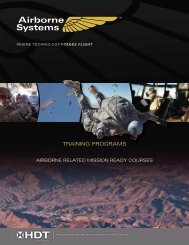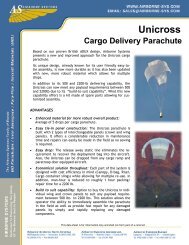You also want an ePaper? Increase the reach of your titles
YUMPU automatically turns print PDFs into web optimized ePapers that Google loves.
<strong>MC</strong>-6<br />
MANEUVERABLE TROOP PARACHUTE SYSTEM<br />
Designed for precision infiltration of <strong>Airborne</strong> Forces, the <strong>MC</strong>-6 features the latest in<br />
advanced design for steerable troop parachutes. It was developed through the Special<br />
Operations Forces Tactical Assault Parachute System (SOFTAPS) program. The <strong>MC</strong>-6 utilizes<br />
the same SF-10A canopy that has been in use by US Special Forces operations. In service for<br />
over ten years, the SF-10A has proven itself to be a safe and reliable design.<br />
<strong>MC</strong>-6 vs. <strong>MC</strong>1—1C<br />
Weight vs. Rate of descent chart<br />
<strong>MC</strong>6 SUB-SYSTEMS<br />
The <strong>MC</strong>-6 is a compilation of three sub-systems: the SF-10A Main Canopy, the T-11R reserve<br />
and the ATPS T-11 Harness.<br />
Main Canopy (SF10A)<br />
The SF-10A Canopy is a highly modified, 28 gore polyconical parachute. The canopy has a<br />
nominal diameter of 32 ft which includes a unique drive system that enables the canopy to<br />
turn quickly with minimum pendular motion. The forward speed can be controlled in-flight<br />
as can the turn-rate. The low descent rate demonstrated by this canopy allows safe<br />
infiltration into all types of drop-zones, including those at high elevations.<br />
T-11R Reserve Parachute<br />
The T-11R is an Aeroconical design based on the current GQ Low<br />
Level Parachute reserve canopy. The T-11R offers Improved reliability,<br />
enhanced deployment techniques, increased structural<br />
strength and is designed to open rapidly with a minimum<br />
post-inflation collapse and minimum altitude loss. The reserve is<br />
designed to inflate in all malfunction modes, as well as with a full<br />
main canopy, should the reserve be deployed inadvertently.
Harness<br />
The harness assembly is a saddle design with multi-directional adjustment. The harness<br />
incorporates two Capewells releases which have been ruggedly designed to meet even<br />
the most stringent requirements. The design of the harness makes it fully adjustable over<br />
the 5th to 95th percentile female/ male range. Four comfort pads are located at the<br />
shoulders and under the leg straps. The two main harness straps can be pre-sized by the<br />
jumper prior to donning the assembly. This harness offers both improved fit and comfort<br />
to the parachutist.<br />
<strong>MC</strong>-6 vs. <strong>MC</strong>1-1C TECHNICAL SPECIFICATION COMPARISON<br />
Item <strong>MC</strong>-6 <strong>MC</strong>1-1C<br />
Parachute Assembly Part Number 11-1-7400 11-1-900-2<br />
NATO Stock Number 1670-01-527-7537 1670-01-262-2359<br />
Nominal Diameter 9.8 meters (32 Feet) 10.7 meters (35 Feet)<br />
Number of Gores 28 30<br />
Canopy Material PIA -C-44378 T4, Low Porosity Nylon MIL/ PIA-C-44378 T1, Low Porosity Nylon<br />
Standard Color Foliage Green Foliage Green<br />
Suspension Line Material PIA-C-5040 Type II PIA-C-5040 Type II<br />
Suspension Line Length 6.5 meters (21.3 feet) 6.7 meters (22 feet)<br />
Suspension Line Tensile Strength 1780N (400 lb) 1780N (400 lb)<br />
Time for 360° Turn 4 seconds 9 seconds<br />
Assembled Weight 13 kg (29 lb) w/o reserve 13 kg (29 lb) w/o reserve<br />
Maximum Exit Weight 181 kg (400 lb) 163 kg (360 lb)<br />
Minimum Exit Altitude 152 m (500 ft) AGL 152 m (500 ft) AGL<br />
Maximum Exit Velocity 150 KEAS 150 KEAS<br />
Rate of Descent See Chart on Page 1 See Chart on Page 1<br />
This data sheet is for information only and shall not form part of a contract<br />
<strong>MC</strong>-6<br />
The SF-10A parachute has demonstrated many superior performance characteristics over-and-above the<br />
<strong>MC</strong>1-1C. The SF-10A has a higher turn-rate and greater forward velocity. A unique feature of the SF-10A is<br />
its ability to back-up in deep brakes. This affords the jumper the ability to easily correct a landing point<br />
overshoot. The <strong>MC</strong>1-1C would require a complete 360° turn to correct a similar overshoot; this would be<br />
hazardous close-to-the-ground. The SF-10A has also demonstrated softer openings at higher elevations<br />
and does not suffer from the type of damage seen on the <strong>MC</strong>1-1C at this deployment condition.<br />
All <strong>Airborne</strong> <strong>Systems</strong> parachutes are manufactured in accordance with current applicable US Army and PIA<br />
(Parachute Industry Association) specifications.<br />
<strong>MC</strong>-6 02052010 © 2010 <strong>Airborne</strong> <strong>Systems</strong> - All Rights Reserved


